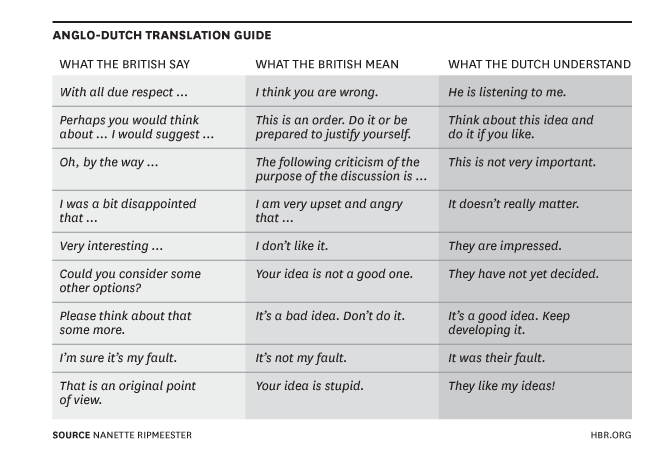Not understanding how certain cultural cues or phrases can be interpreted in the workplace can cause many problems. What you say and how you say it can be understood differently depending on a colleague’s nationality. For instance, when a British manager tells a Dutch colleague, “That’s very interesting…” what they likely mean is, “I don’t like it,” while the Dutch colleague may interpret it as, “I’m impressed.” With our global economy, these nuances will have increasing importance when it comes to attracting and hiring job candidates.
Harvard Business Review recently spelled out subtle differences like the one above in its tongue-in-cheek guide “How to Say ‘This is Crap’ in Different Cultures.” The guide points out how even seemingly inconsequential misunderstandings among Dutch and British colleagues can have dramatic results.
Here are a few more examples:

So what about U.S. employers and hiring managers? Even if you don’t plan on hiring job candidates from outside the country, the global workforce will likely come to you. From 2007 to 2011, government data show that more than three-fourths of Texas’s net job growth is attributed to newly arrived non-U.S. citizens.
What signals are you sending out that are being misinterpreted?
Words and tone: Watch your use of business slang or buzz phrases. “Self-starter” and “team player” may not hold the same meaning for all job candidates. At best, using the wrong wording or phrasing can result in a good chuckle around the water cooler. One consultant told us that she once stopped an Israeli colleague from telling an American business consulting client, “We will penetrate every person in your market!” Yikes. In addition, watch your use of humor and, specifically, sarcasm which can go completely undetected in certain cultural contexts.
Directness: U.S. employers are notoriously direct. Expecting the same from all job candidates or employees is unfair and, frankly, unrealistic. Don’t mistake a lack of directness with a lack of knowledge or passion about the job. According to Lifehack, the best business communicators listen, relate well to others and ask plenty of questions. These qualities are highly valued in other cultures but not necessarily in many U.S. workplaces. What about yours?
Non-verbal communication: Once the hiring process starts, it’s important to consider non-verbal cues. For instance, in the U.S., direct eye-to-eye contact is a sign of respect. However, in many other cultures, avoiding direct eye-to-eye contact is necessary in order to show respect. Don’t treat the latter necessarily as a lack of confidence. For more on the subject, take a look at this guide for Brazilian versus U.S. cultural cue differences.
Some serious consequences can occur when employers don’t fully understand or respect cultural differences in the workplace. In a worst-case scenario, the U.S. Equal Employment Opportunity Commission (EEOC) could get involved. Recently the EEOC sued United Parcel Service Inc. (UPS) for discriminatory practices against job applicants and workers whose religious practices conflicted with the company’s uniform and appearance policies. What helped to hasten the lawsuit? One UPS manager told a Muslim employee that “God would understand” if he shaved his beard. Messages like these are red flags that cultural misunderstandings are a systemic problem that should be addressed in a very serious manner.
Finally, it’s important to understand the difference between recruiting within the U.S. and outside the U.S. If you choose to recruit in other countries, your job posting or hiring process may not only be lost in translation, it may actually be illegal. Job advertising, marketing, interviewing and pre-employment screening practices around the globe vary greatly. Employment agencies can help navigate this legal minefield.
What have you done to increase your own company’s success in recruiting, hiring and retaining a multi-cultural workforce that communicates well together?
Image Copyright: rawpixel / 123RF Stock Photo




